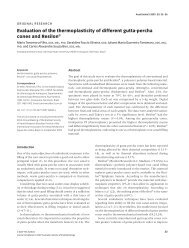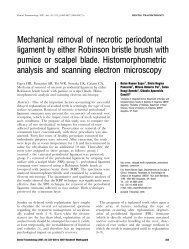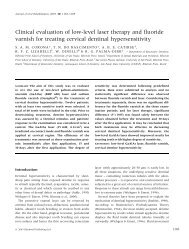Antimicrobial and mechanical properties of acrylic resins with ...
Antimicrobial and mechanical properties of acrylic resins with ...
Antimicrobial and mechanical properties of acrylic resins with ...
You also want an ePaper? Increase the reach of your titles
YUMPU automatically turns print PDFs into web optimized ePapers that Google loves.
2 L.A. Casemiro et al.incorporation <strong>of</strong> antimicrobials into denture basematerials 8,10–16 .The addition <strong>of</strong> antimicrobial agents to dentalmaterials is part <strong>of</strong> a current trend 8,10–20 . Amongthe advantages <strong>of</strong> this process is the possibility <strong>of</strong>eluting the agents from the base materials, thuspreventing or reducing bacterial, fungal <strong>and</strong> yeastcontamination.<strong>Antimicrobial</strong> zeolites have been incorporated toserve such a purpose 10,11,13–15,21,22 . Zeolites arealuminum silicate crystalline structures that presentvoid spaces measuring 3–10 angstroms in theirstructure. <strong>Antimicrobial</strong> cations, such as silver <strong>and</strong>zinc, may be lodged <strong>with</strong>in the void spaces <strong>of</strong> thezeolites <strong>and</strong> be exchanged over time <strong>with</strong> othercations from their environment 14,20–22 . As this ionavailability occurs, the free cations come into contact<strong>with</strong> the environmental microorganisms, suppressingtheir development by inactivating vitalmicrobial enzymes, interrupting RNA replication<strong>and</strong> blocking their respiration by an oxidativeprocess 23–31 . The efficacy <strong>of</strong> antimicrobial zeolitesagainst aerobic <strong>and</strong> anaerobic bacteria <strong>and</strong> fungihas been demonstrated 20,24,32,33 .Because <strong>of</strong> their characteristics, including prolongedantimicrobial activity, low toxicity <strong>and</strong> lack<strong>of</strong> odour or flavour, zeolites have a large range <strong>of</strong>applications. They have been incorporated, amongothers, into polymers for packaging <strong>of</strong> food, paint,tissue, catheter <strong>and</strong> orthopedic prostheses, dentalrestorative materials <strong>and</strong> oral hygiene products13,14,20,22,34–45 . The dental materials most frequentlyassociated <strong>with</strong> antimicrobial zeolites arethe tissue conditioners. The favourable outcome <strong>of</strong>this association from a microbiological st<strong>and</strong>point14,20 as well as their good viscoelastic <strong>properties</strong>15 <strong>and</strong> biocompatibility 11 , indicate that zeolitesmight also be successfully associated <strong>with</strong> othermaterials used for denture fabrication. Althoughthis procedure might potentially bring direct benefitsfor denture wearers, there have only beenlimited investigations into the addition <strong>of</strong> antimicrobialagents to <strong>acrylic</strong> resin denture bases 16,46 .The purposes <strong>of</strong> this in vitro study were to evaluatethe antimicrobial activity <strong>of</strong> <strong>acrylic</strong> <strong>resins</strong>containing different percentages <strong>of</strong> silver–zincantimicrobial zeolites, <strong>and</strong> to assess whether theaddition <strong>of</strong> zeolites alters the flexural <strong>and</strong> impactstrength <strong>of</strong> the denture bases.Material <strong>and</strong> methodsThe study was conducted under climate-controlledconditions (23 ± 2°C; 50 ± 10% relative airhumidity).Specimen fabricationThe tested materials <strong>with</strong> their compositions,specifications <strong>and</strong> manufacturers are listed inTable 1. Stainless steel rectangular-shaped patterns(8 · 10 · 4mm) were invested in flasks <strong>with</strong> dentalstone. After the setting <strong>of</strong> the stone, the flasks wereopened <strong>and</strong> the patterns removed, leaving rectangular-shapedcavities that were used as matrixes forthe fabrication <strong>of</strong> heat-polymerised <strong>acrylic</strong> <strong>resins</strong>pecimens.For each assay, 50 specimens were fabricatedfrom each material [a microwave-polymerised(Onda-Cryl) <strong>and</strong> two heat-polymerised (QC20 <strong>and</strong>Lucitone 550) <strong>acrylic</strong> <strong>resins</strong>], <strong>and</strong> assigned to fivegroups (n = 10) according to their percentage <strong>of</strong>silver–zinc zeolite (Irgaguard B5000; Ciba SpecialtyChemicals Corporation, Tarrytown NY, USA): 0%(control); 2.5%; 5.0%, 7.5% <strong>and</strong> 10.0% by drywet). For this, the materials were weighted in ananalytical balance (Fisher Scientific, Pittsburgh PA,USA) <strong>and</strong> Irgaguard B5000 (zeolite) was incorporated,in pre-defined percentages, to the polymerpowder <strong>of</strong> the <strong>acrylic</strong> <strong>resins</strong>. These were mixedmanually for 3 min, by the same operator, toobtain an adequate particle distribution. TheTable 1 Tested materials.Material Manufacturer H<strong>and</strong>ling dose Type <strong>of</strong> polymerisationQC20High impactLucitone 550Onda-CrylDentsply Indústria e Comércio Ltda,Petrópolis, RJ, BrazilDentsply Indústria e Comércio Ltda,Petrópolis, RJ, BrazilClássico Artigos Odontológicos Ltda.,São Paulo, SP, Brazil23g:10 ml Heat-polymerised (immersion inboiling water for 20 min)21g:10 ml Heat-polymerised (immersion inwater at 73°C for 90 min <strong>and</strong>boiling water for 30 min)7g:21 ml Microwave-polymerised <strong>with</strong> 500Wpower (3 min at 40% power, 4 min rest,then 3 min at 90% power)Ó 2008 The Gerodontology Association <strong>and</strong> Blackwell Munksgaard Ltd, Gerodontology 2008; doi:10.1111/j.1741-2358.2007.00198.x






